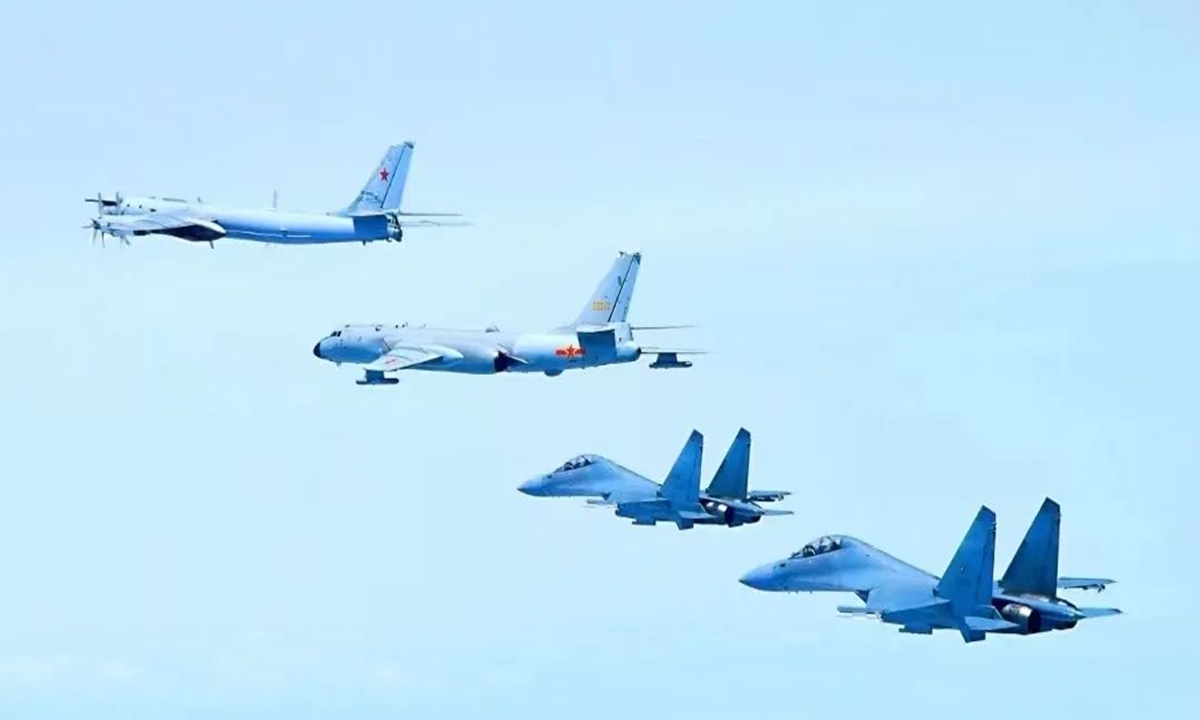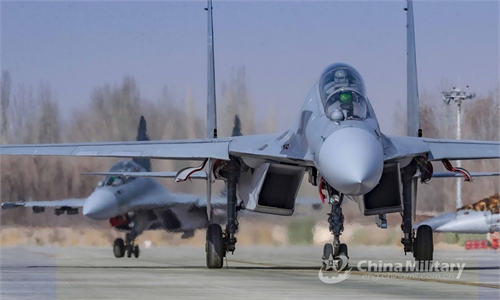Australia’s military provocations on China, accusations of PLA’s legitimate countermeasures reflect own anxiety

Two Chinese J-16 fighter jets conduct an escort mission for a Chinese H-6K bomber and a Russian Tu-95MS bomber during a regular China-Russia joint strategic patrol above the Sea of Japan, the East China Sea and the West Pacific on May 24, 2022. Photo: Screenshot from China Central Television
Australia's Defense Ministry on Sunday said that a P-8 maritime surveillance aircraft of the Royal Australian Air Force was intercepted by a Chinese J-16 fighter aircraft during a so-called routine maritime surveillance activity in the South China Sea on May 26, claiming the intercept resulted in a dangerous maneuver which posed a safety threat to the P-8 aircraft and its crew. But the truth is, it was the Australian aircraft that provoked first and attempted to enter areas under China's sovereign jurisdiction, and the Chinese warplane was left with no choice but to warn away the Australian spy plane in order to safeguard China's sovereign security. Canberra's nonsensical logic exposes Australia's anxiety to eagerly prove its worthiness to the US, and also the pressure that Australia feels from China's win-win cooperation with countries in the South Pacific.
In February, when a flotilla of the Chinese People's Liberation Army (PLA) Navy was on far sea drills and sailed in international waters to the north of Australia, an Australian P-8 aircraft flew very close to the Chinese vessels and dropped sonobuoys near them, while the Chinese vessels maintained safe, standard and professional actions. It was also Australia that jumped out first and accused the PLA flotilla of pointing a laser at its aircraft, without revealing how close the aircraft was to the Chinese ships, how provocative it was to drop sonobuoys near them, or how the aircraft could disrupt normal navigation and bring safety risks.
It has become clear that Australia is using a pattern to hype the "China military threat" theory, and similar scenario will happen again and again: Australia will send its aircraft or vessels to provoke Chinese military plane or vessel first, then when China takes countermeasures, Australia will accuse China's countermeasures of being threats, without giving the context that they are meant to be countermeasures and Australia is the one that took the dangerous move first.
Australia is thousands of kilometers away from China and has no territorial dispute with China. Economic cooperation between the two countries could benefit both. China doesn't see Australia as a threat, and surely it never intends to be a threat to Australia.
Ever since the US started to see China as its top rival and moved to contain the development of China, other members of the Five Eyes alliances including Australia started to follow its lead. After joining the AUKUS alliance, further serving as a vanguard of the US in confronting China militarily, Australia has ramped up its military moves against China in an attempt to prove its worthiness to the US. This includes the development of nuclear-powered attack submarines, expanding defense expenditure and building a large submarine base that can also host US and UK submarines, in addition to the unreasonable, double-standards smearing of the PLA countermeasures despite Canberra was the one that triggered them.
Australia is now anxious and nervous. Not only does Australia want to please the US, but also its repeated political, economic and military provocations against China over the past few years have backfired and now haunt it deep in its guilty conscience: China is now stepping up efforts to boost cooperation with countries in the South Pacific.
The cooperation between China and Pacific Island countries are for the purpose of mutual benefits and for the development of all parties involved. It is not aimed at Australia, but Australia certainly sees it that way, and that is why Australia is doing all it can to defame China, trying to depict China as a threat to the international community.
It is expected that Australia could further expand its provocations and false charges against China. In addition to making up new accusations according to the recent pattern, Australia could send more aircraft and vessels to the South China Sea for so-called freedom of navigation operations and trespass on Chinese territorial waters and airspace. It could also interfere with the Taiwan question by participating in drills led by countries like the US and Japan, send warships through the Taiwan Straits, make military exchanges with armed forces on the island of Taiwan or sell arms to the island, following what the US has been doing.
Australia must understand that China's comprehensive national strength is much larger than Australia's, not to mention the huge gap between the two countries' military strength. Australia is daring to provoke China in this way only because of its master, the US. But in the end, Australia is no US. The PLA takes resolute measures even against US military provocations, and Australia should expect nothing less. If Australia continues to test China's bottom lines, it should prepare to see more powerful countermeasures from China than tactical moves like aircraft intercept with flare and chaff or laser-pointing with rangefinders.
The author is a reporter with the Global Times. liuxuanzun@globaltimes.com.cn


